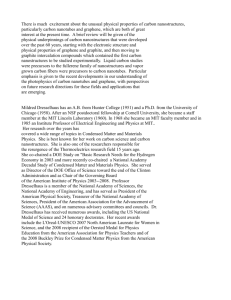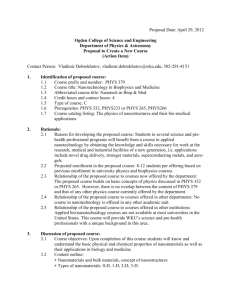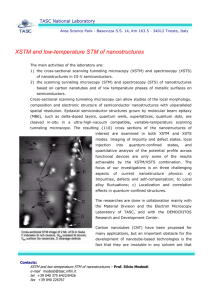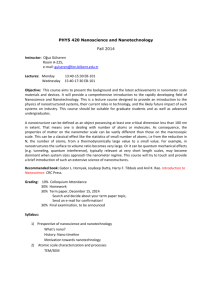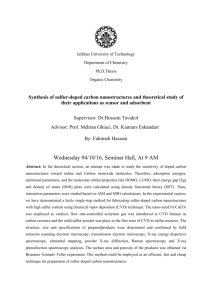Science relating to Nanotechology, Endocrine Disrupters and
advertisement
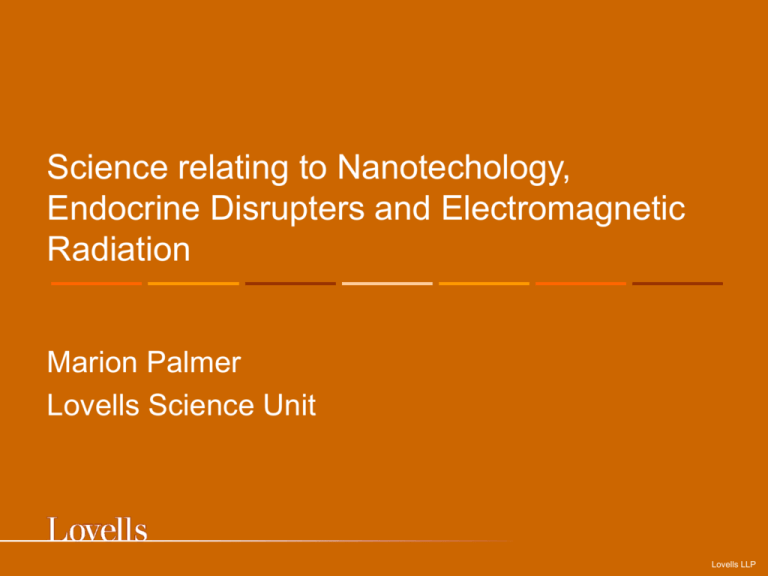
Science relating to Nanotechology, Endocrine Disrupters and Electromagnetic Radiation Marion Palmer Lovells Science Unit Lovells LLP Overview • Nanotechnology – Nanostructures & how nanotechnology works – Applications – Concerns and risks associated with nanotechnology – Carbon nanotubes Overview • Endocrine Disrupters – Endocrine system and hormones – How endocrine disrupters work – Sources of potential endocrine disrupters – Concerns and risks associated with endocrine disrupters – TBT and DES Overview • Electromagnetic Radiation – EMF spectrum – Electric and magnetic fields – Low frequency magnetic fields – Radiofrequency radiation Nanotechnology Lovells LLP Definition • No accepted definition at present – Nanoscience is the study of phenomena and manipulation of materials at atomic, molecular and macromolecular scales, where properties differ significantly from those at a larger scale. – Nanotechnologies are the design, characterisation, production and application of structures, devices and systems by controlling shape and size at nanometre scale. Millimetre scale (1 m = 1000 mm) ant and flea • 5 mm • 1mm http://www.nationalinsectweek.co.uk/resources/buzz_ant_06.pdf www.nanotec.org.uk/report/chapter2.pdf Micrometre scale (1 mm = 1000 µm) eye of a fruit fly and a red blood cell • 400 µm • 7 µm http://www.molbio1.princeton.edu/facility/confocal/sem/imagelist1.html www.mta.ca/dmf/blood.htm Nanometre scale (1 µm = 1000 nm) – viruses & DNA • 50 – 100 nm • 2 nm www.answers.com/topic/virus http://www.gala-instrumente.de/images/deben_CCD_DNA.jpg Nanostructures • Nanoparticles Nanostructures • Carbon nanotubes and buckyballs Nanostructures • Quantum dots http://www.nist.gov/public_affairs/update/quantumdots.htm Nanostructures • Non-carbon nanotubes • Nanowires http://www.nist.gov/public_affairs/05nano_image_gallery.htm • Biopolymers • Dendrimers http://nano.med.umich.edu/projects/dendrimers.html How does nanotechnology work? • As objects get smaller they have a much greater surface area to volume ratio 10 cm cube has a surface area of 600 cm2 and a volume of 1000 cm3 (ratio = 0.6) 2 cm cube has a surface area of 24 cm2 and a volume of 8 cm3 (ratio = 3) How does nanotechnology work? • At very small sizes quantum effects come into play which can result in changes to a particles magnetic, electric and optical properties. http://www.omicron.de/index2.html?/re sults/spin_polarized_tunneling_induce d_luminescence_microcopy_sp_tilm/in dex.html~Omicron Applications • Antibacterial effect of silver www.nanotech-now.com Applications • Coatings - self-cleaning windows and stainproof clothing Applications • Microchips •http://ion.asu.edu/cool66_IC2/cool66_ic_thumb.htm Applications • Sun sunscreens and cosmetics Applications • Catalysts – Envirox™ cerium oxide • Nanoremediation – SAMMS technology to remove mercury • Paper – photographic paper • Filters – nanofibres • Toothpaste – to remineralise teeth • Food – packaging • Paint – improved adhesion and antifungal qualities/anti-graffiti • Clothes – non-staining and anti-radiation • Batteries – (Black & Decker) phosphate nanocrystal technology • Cleaning products Future Applications • First Generation ~ 2001: Passive nanostructures – Nano-structured coatings, nanoparticles, nanostructured metals, polymers, ceramics, catalysts, composites, displays • Second Generation ~ Now: Active nanostructures – Transistors, amplifiers, targeted drugs and chemicals, actuators, adaptive structures, sensors, diagnostic assays, fuel cells, solar cells, high performance nanocomposites, ceramics, metals • Third Generation ~ 2010: 3-D nanosystems and systems of nanosystems – Various assembly techniques, networking at the nanoscale and new architectures, Biomimetic materials, novel therapeutics/targeted drug delivery • Fourth Generation ~ 2015: Molecular nanosystems – Molecular devices “by design”, atomic design, emerging functions Why is there so much concern about nanotechnology • Currently not possible to detect most nanostructures without sophisticated equipment • Small size may result in greater dispersal than larger structures • Small size may result in particles passing into the body more easily (inhalation, ingestion, absorption) • May be more reactive due to surface area to volume ratio • May be processed differently by the body in comparison to larger structures • Greater potential to adsorb toxic chemicals • Persistence Potentials risks associated with nanotechnology • Adverse health effects in humans from deliberate or accidental exposure • Adverse effects on the environment from deliberate or accidental exposure • Potentially explosive properties of nanostructures • “Grey goo” • Futuristic scenarios Toxicological difficulties • No standardised terminology and method of measurement • All structures are likely to have a unique toxicological profile • Longevity of particles in the environment and body are unknown • Particle size may be less important than the surface characteristics of the material • Standard dose response may not be appropriate Carbon nanotubes http://www.nano-lab.com/nanotube-image.html Example – Carbon Nanotubes • Commercially produced by companies such as Thomas Swan • Very desirable product http://www.tennis.com/yo urgame/gear/racquets/babo lat/babolat.aspx?id=56932 Potential applications of carbon nanotubes Materials & Chemistry - Ceramic and metallic CNT composites - Polymer CNT composites (heat conducting polymers) - Coatings (e.g. conductive surfaces) - Membranes and catalysis - Tips of Scanning Probe Microscopes (SPM) Medicine & Life Science - Medical diagnosis (e.g. Lab on a Chip (LOC)) - Medical applications (e.g. drug delivery) - Chemical sensors - Filters for water and food treatment Electronics & ICT - Lighting elements, CNT based field emission displays - Microelectronic: Single electron transistor - Molecular computing and data storage - Ultra-sensitive electromechanical sensors - Micro-Electro-Mechanical Systems (MEMS) Energy - Hydrogen storage, energy storage (super capacitors) - Solar cells - Fuel cells - Superconductive materials Carbon nanotubes • Have raised concerns due to a superficial likeness to asbestos fibres and extreme durability • Potential exposures during manufacturing, processing, product use and disposal • Have been researched more than most manufactured nanostructures Research summary • Results have been variable dependent on dose, testing model, purity and type of nanostructure • Research results to date: – Some coated CNTs appear to move freely throughout the body (mice) whereas others are rapidly excreted – Installation experiments have shown inflammation and fibrosis – Inhalation experiments have shown small changes in the lung – Effects on the immune system – Effects on cell growth and death – Modification of tube coating by aquatic organisms
